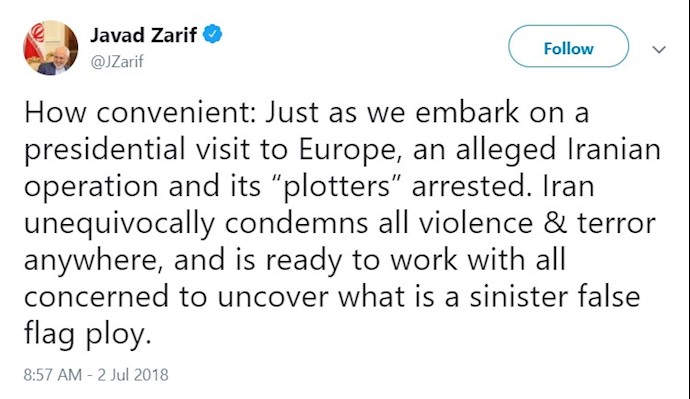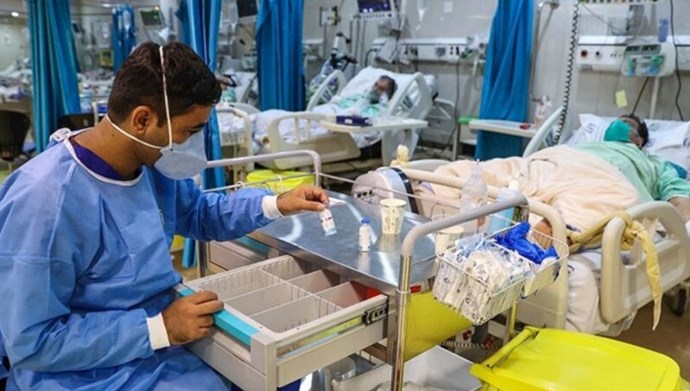Analysis by PMOI/MEK
Oct. 14, 2018 – The arrest of Assadollah Assadi, a Vienna-based Iranian diplomat, on July 1, 2018, by German police on terrorism charges set a series of developments in motion that can have far wider repercussion for the Iranian regime than is initially evident.
On June 30, Iranian exile community members gathered in Paris for an annual rally of the National Council of Resistance of Iran (NCRI), an umbrella organization for a broad range of Iranian factions opposing the mullah regime in Iran.
On the same day two Belgian citizens of Iranian descent—a couple known as Nasimeh Naami and Amir Saadouni, were arrested by Belgian police, carrying half a kilogram of TATP explosives and a detonator hidden in a toiletries bag.
The French police arrested another Iranian, identified only as Mehrdad A, in Paris, where the rally was taking place. He was accused of being accomplice in the plot.
The next day on July 1, German police in Bavaria arrested an Iranian diplomat, Assadollah Assadi, after he pulled over his rented van at a gas station on the autobahn near the city of Aschaffenburg. German authorities summoned a bomb squad, suspecting that Assadi might be carrying more explosives. The Iranian diplomat is accused of plotting the terrorist attack and delivering the explosive to the Iranian couple.
Already ripe for a Hollywood blockbuster, this was just the beginning of an international fiasco for the Iranian regime that encompassed half of Europe from Belgium and France to Germany and Austria.
Assadi is a high-ranking officer of the Iranian Ministry for Intelligence and its station chief in Austria since 2014.
According to NCRI’s Committee of Security and Counter Terrorism, MOIS’ station chief in Austria before Assadi was Mostafa Roudaki, who in 2017 was transferred to Albania where a large number of MEK members reside. That has something to say for the importance of the Austrian station to the Iranian regime’s Ministry of Intelligence.
Not surprisingly, the Iranian regime’s propaganda machine started to blame everyone except for the true perpetrators right away.
“How convenient: Just as we embark on a presidential visit to Europe, an alleged Iranian operation and its “plotters” arrested. Iran unequivocally condemns all violence & terror anywhere, and is ready to work with all concerned to uncover what is a sinister false flag ploy,” Javad Zarif, Iran’s Foreign Minister tweeted on July 2.

Javad Zarif, Iran’s Foreign Minister tweet
Iran’s Foreign Ministry swiftly accused the NCRI to have plotted the attack on itself to damage Iran’s reputation.
Bahram Qassemi, Iran’s Foreign Ministry spokesperson, told reporters that his country has evidence that the attack was plotted by a terrorist organization, without producing any proof.
“The latest scenario has been planned and carried out to damage Iran-Europe ties amid such sensitive and crucial times,” he said.
Austria promptly asked Iran to strip Assadi of his diplomatic status giving the country a 48-hour ultimatum. The Iranian mullahs of course, having plotted and planned the attack and fearing a fallout among their agents across the world, didn’t comply and Austria went ahead to do so itself.
Meanwhile, Belgium filed an extradition request for Assadi with German authorities since the Iranian couple had been arrested in its territory and the explosives as it turned out had been given to them in Belgium.
The German prosecution charged Assadi with activity as a foreign agent and conspiracy to commit murder. Assadi is a member of the Iranian intelligence service “Ministry of Intelligence and Security”, whose tasks “primarily include the intensive observation and combating of opposition groups inside and outside of Iran,” the German prosecutors said.
For a few weeks, a legal battle ensued over Assadi’s status, his defense contending that he enjoys diplomatic immunity under the Vienna Convention on Diplomatic Relations. Sources reveal that the Iranian regime intended to put the Austrian government under pressure to send Assadi back to Iran after he was released from German detention.
On October 1, the Bamberg state court in Germany approved the extradition of Assadi to Belgium. According to the court ruling, diplomatic immunity did not apply in the case because Assadi was on holiday in Germany and not in transit between Iran and Austria. German prosecutors had previously said that their investigation wouldn’t hinder Belgium’s extradition request.
A day later, French intelligence concluded that Iran’s intelligence ministry had ordered the attack.
“Behind all this was a long, meticulous and detailed investigation by our (intelligence) services that enabled us to reach the conclusion, without any doubt, that responsibility fell on the intelligence ministry,” a source from the French intelligence told Reuters.
The source added that deputy minister and director general of intelligence Saeid Hashemi Moghadam had ordered the foiled attack.
Simultaneously, France seized assets belonging to Iran’s intelligence services and two Iranian nationals. A joint statement by the foreign, interior and economy ministries of France read: “An attempted attack in Villepinte was foiled on June 30. An incident of such gravity on our national territory could not go unpunished.” France’s Macron had previously warned about a firm response.
On October 9, Assadi was transferred to Belgium. A day later, Belgian prosecutors said that Assadi was charged along with the other three Iranians with planning to bomb the annual meeting of the NCRI in Paris.





